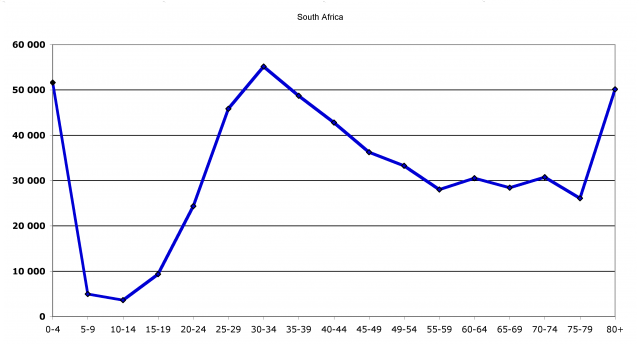You are hereA response to Rian Malan's "last ever AIDS piece"
A response to Rian Malan's "last ever AIDS piece"
Rian Malan continues to befuddle AIDS statistics by Eduard Grebe I should be very happy if Rian Malan's so-called “last ever Aids piece” (noseweek, nose88) is truly his last, since he shows no sign of changing his habit of serious errors of logic and deliberate distortions when writing on Aids. His disingenuous suggestion that the shocking rise in in the number of registered deaths is merely the result of improved death registration and therefore nothing to worry about, is based on misinterpretations and what can be none other than deliberate distortion of the data. Malan suggests that the increases in registered deaths are primarily the result of improved registration and not the HIV epidemic. However, there are two glaring features of the data that he fails to account for. First, the age-distribution of registered deaths is completely contrary to the distribution in any normal country: in South Africa, adult deaths are concentrated in the population of working and sexually active age, whereas in countries without a devastating Aids epidemic, adult deaths are concentrated among older people. This is shown very clearly, and disturbingly, by the graph below of deaths by age in 2003 derived from Stats SA. How could Malan account for this distribution other than by a devastating HIV epidemic? (Incidentally, I use 2003 rather than 2004, because recorded deaths in the latest year for which Stats SA reports are often not all accounted for.)
 Registered deaths in South Africa (2003)
Registered deaths in South Africa (2003)
Second, deaths from diseases associated with HIV/Aids have increased far more than have those from other causes. For example, the increase in the recorded deaths resulting from causes typically associated with Aids (TB, intestinal diseases, influenza and pneumonia, CNS inflammation, HIV and immune system disorders) between 1997 and 2003 was over 230%, but the overall increase was 75% (91% for all deaths due to natural causes). So even if we adjusted for the effect of improved registrations (which should be evenly spread across categories), there would have been a shockingly large increase in deaths in these categories. Another disingenuous use of the figures is Malan's cherry-picking of categories that seem to illustrate his point, without looking at what underlies those figures. For example, he uses the assault category – a sub-category of unnatural causes of death. While deaths attributed to assault did increase substantially, the number of deaths as a result of unnatural causes actually declined over the period. Those unnatural deaths researchers were unable to classify declined sharply. This suggests that the sharp increase in assault deaths more likely reflects improved categorisation than increased death registration. The table below compares some of the categories associated with Aids with those Malan cites as proof that registrations are behind the increases.
Changes in cause of death (1997-2003)
| Cause of death | Deaths | % change | |
| 1997 | 2003 | ||
| Influenza&pneumonia | 11 518 | 45 351 | 294% |
| Intestinal infectious diseases | 6 536 | 24 394 | 273% |
| TB | 22 071 | 67 609 | 206% |
| Road accident | 1 737 | 4 456 | 157% |
| Aplastic and other anaemias | 1 210 | 2 818 | 133% |
| Assault | 1 351 | 2 572 | 90% |
| Renal failure | 3 429 | 5 851 | 71% |
| Stroke | 17 004 | 27 445 | 61% |
| Hypertension | 7 709 | 11 678 | 51% |
| Breast cancer | 1 618 | 2 161 | 34% |
The reliance on unbsubstantiated innuendo is a staple of conspiracy theorists everywhere. So is championing crackpot “scientists” like Rodney Richards and painting their spurning by the scientific community not as a form of peer review, but as collective blindness or a vast global conspiracy. For example, his suggestion that some “Aids faction” released mortality data for sinister reasons is in no way substantiated. Later, he suggests that there is a conspiracy between UNAIDS and StatsSA to massage the latter's figures in order to protect UNAIDS's reputation. What incentive could StatsSA possibly have to manipulate the South African deaths registration data for UNAids's benefit? While there are many more errors that could be pointed out in Malan's piece, these should suffice to show that it is not to be taken seriously. Eeven though Malan seems to have changed his earlier views and now acknowledges that there is a serious HIV epidemic, his arguments are as bad but potentially harmful as ever. Eduard Grebe is former TAC Treatment Project Coordinator and a researcher at the University of Cape Town's AIDS & Society Research Unit. He writes in his personal capacity. [email protected]
